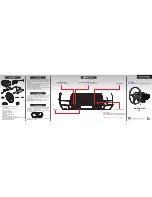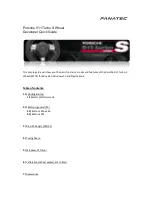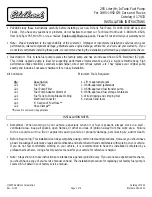
Analog Manifold Absolute Pressure (MAP) Sensor
• Theory of Operation
Almost all domestic and import MAP sensors are analog types in design except Ford’s MAP sensor. Analog MAP
sensors generate a variable voltage output signal that is directly proportional to the intake manifold vacuum, which is
used by the PCM to determine the engine load. They are primarily three wire sensors and are supplied with 5V V
Ref power, a ground circuit, and the signal output to the PCM.
High pressure occurs when the engine is under a heavy load, and low pressure (high intake vacuum) occurs when
there is very little load. A bad MAP sensor can affect the air-fuel ratio when the engine accelerates and decelerates.
It may also have some effect on ignition timing and other PCM outputs. A bad MAP sensor or its hose can trigger
DTC’s for MAF, TP, or EGR sensors.
• Symptoms [OBD II DTC’s: P0105 ~ P0109]
Low power, stall, hesitation, excessive fuel consumption, emissions failure
• Test Procedure
1. Connect the CH A lead to the sensor output or HI and its ground lead to the sensor output LO or GND.
2. Shut off all accessories, start the engine and let it idle in park or neutral. After the idle has stabilized, check the
idle voltage.
3. Rev the engine from idle to Wide Open Throttle (WOT) with a moderate input speed (this should only take about
2 seconds - don’t overrev the engine.)
4. Let engine speed drop back down to idle for about two seconds.
5. Rev the engine again to WOT (very quickly) and let it drop back to idle again.
6. Press the HOLD key to freeze the waveform on the display for closer inspection.
NOTE
It may be advantageous to put the sensor through its paces by using a handheld
vacuum pump to see that it generates the correct voltage at a specific vacuum.
• Reference Waveform
VEHICLE INFORMATIONS
YEAR
: 1993
MAKE
: Chevrolet
MODEL
: Suburban 1500
ENGINE
: 5.7 L
FUELSYS : Throttle Body Fuel Injection
PCM_PIN : B13 LtGrn wire at MAP sensor
STATUS
: KOER (Key On Running)
RPM
: Acceleration & Deceleration
ENG_TMP : Operating Temperature
0VACUUM : 3-24 In. Hg
MILEAGE : 55011
6-23
MAX = 4.86 V
MIN = -133 mV
slow
accel.
Idle
Snap
accel.
Full
decel.
• Symptoms [OBD II DTC’s: P0500 ~ P0503]
Improper transmission shifting, inaccurate speedometer, problems affecting ABS and cruise control
• Test Procedure
1. Raise the drive wheels off the ground and place the transmission in drive.
2. Connect the CH A lead to the sensor output or HI and its ground lead to the sensor output LO or GND.
3. With KOBD (Key On, Being Driven), monitor the VSS output signal at low speed (about 30 MPH) while gradually
increasing the speed of the drive wheels.
4. Use the Glitch Snare mode the detect spikes and dropouts.
• Reference Waveform
VEHICLE INFORMATIONS
YEAR
: 1984
MAKE
: Oldsmobile
MODEL
: Toronado
ENGINE
: 5.0 L
FUELSYS : Feedback Carburetor
PCM_PIN : 16 Brn wire
STATUS
: KOBD (Key On Being Driven)
RPM
: 1350
ENG_TMP : Operating Temperature
VACUUM : 15 In. Hg
MILEAGE : 52624
• Troubleshooting Tips
The top and bottom corners of the waveform should be sharp and voltage transitions of the edge should be straight
and vertical.
All of the waveforms should be equal in height due to the constant supply voltage to the sensor.
Make sure the waveform isn’t riding too high off the ground level. This could indicate a high resistance or bad ground
supply to the sensor. (Voltage drop to ground should not exceed 400 mV.)
Look for abnormalities observed in the waveform to coincide with a driveability problem or a DTC.
6-22
The signal frequency should increase with increasing vehicle speed, but the duty cycle
should stay consistent at any speed. The amplitude, frequency, and shape should be
all consistent in the waveform from pulse to pulse. The amplitude should be sufficient
(usually equal to sensor supply voltage), the time between pulses repeatable and the
shapes repeatable and predictable.
FREQ = 19.2 Hz
MAX = 12.0 V
MIN = 0.00 V
Frequency Modulated Signal.
Frequency increases with
vehicle speed.
















































